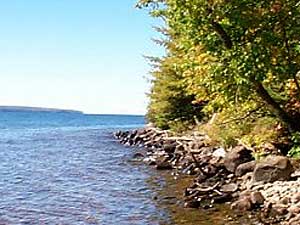|
Audio
Photos
Resources
Your Voice
|
Making the Apostle Islands wild
September 2, 2004
The National Park Service is moving ahead with wilderness designation for much of northern Wisconsin's Apostle Islands National Lakeshore. A park official announced the designation Thursday in Ashland. But some wilderness supporters are crying foul. They say the announcement smells of politics, and that too little of the Lake Superior park will actually get wilderness management.
Duluth, Minn. — The Apostle Islands National Lakeshore includes 21 islands and a small portion of the mainland around Bayfield, Wisconsin. It does not include Madeline Island, the largest and most populated of the island group.
The designation will place 80 percent of the park into the Federal Wilderness Protection system. That's more than 33,000 acres out of the 42,000-acre park. Where it's wilderness, there will be no buildings built, no roads or sidewalks, no docks or even information signs. Jim Nepstad, a manager for the Apostle Islands National Lakeshore, says it's what the public wanted.
"We met with the public on a huge number of occasions, and received roughly 10,000 comments over the course of the entire study," says Nepstad. "So, the amount of the public involvement in this particular decision was -- for this park anyway -- unprecedented."
Nepstad says the public was strongly in favor of wilderness, but people were concerned about putting the protection on some particular places.
"They didn't want docks, and existing visitor centers and so on, to be within the wilderness recommendation," Nepstad says. "They didn't want, for the most part, the mainland unit of the park being within the wilderness boundaries as well."
Three of the park's islands are being left outside the wilderness. Basswood and Sand Islands have potential for future visitor facilities, while Long Island has a relatively high day use. Nepstad says the islands have a long history of human activity.
|
When you realize that for the last 15 years, since 1989, the Apostle Islands has had 97 percent of its land protected as wilderness, it doesn't seem to much to ask to continue with that same protection.
- Sean Wherley, Friends of the Boundary Waters Wilderness |
"Lots of structures, historic quarries and so on," Nepstad says. "And a lot of our visitors would like us to be able to manage those pretty much as they've been managed all along, but maybe put up an information sign here or there and help better tell the stories of those particular places."
But some wilderness advocates aren't happy. While 80 percent of the park will be wilderness, a 1989 management plan recommended wilderness for much more. Sean Wherley is with the group Friends of the Boundary Waters Canoe Area Wilderness.
"Eighty percent is a good starting point," says Sean Wherley of the Friends of the Boundary Waters Canoe Area Wilderness. "But when you realize that for the last 15 years, since 1989, the Apostle Islands has had 97 percent of its land protected as wilderness, it doesn't seem too much to ask to continue with that same protection."
And Wherley suspects a political connection. The Bush administration is making the announcement on the eve of Friday's 40th anniversary of the Federal Wilderness Act. And Wherley says the announcement affects a state considered key to President Bush's re-election.
"There's been no desire to protect wilderness elsewhere, and all of the sudden this has come to their attention," Wherley says. "This policy, or this study, was actually unveiled March 30 by the Park Service. Why now it's occurring is a little confusing to the general public."
And, Wherley says, the designation is not characteristic of the administration.
"The Bush administration has been reluctant to support wilderness designations nationwide," Wherley says. "(Bush has) signed fewer wilderness bills than even his father's administration, and has turned his back on the potential to protect up to 60 million acres of wilderness quality lands on our national forests."
Apostle Islands official Jim Nepstad says there's nothing unusual about the timing of the announcement. Such a designation would typically follow several weeks after the end of a wilderness study.
The Thursday announcement will be followed with the decision's publication Friday in the Federal Register. To take effect, the recommendation will require Congressional approval.
|
News Headlines
|
Related Subjects
|

